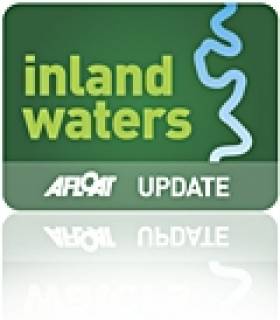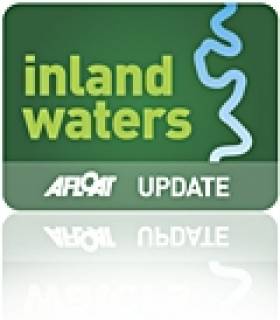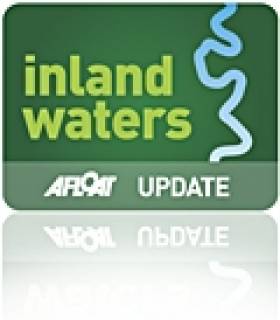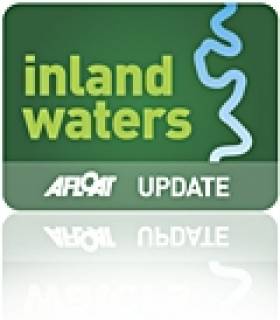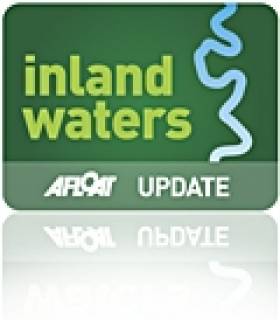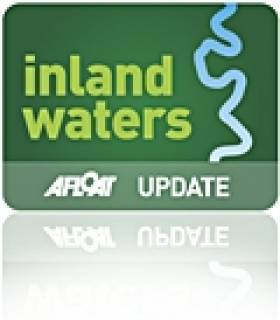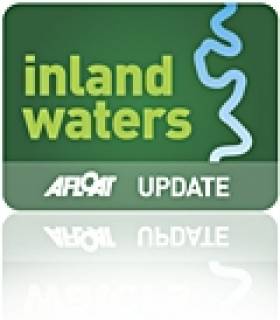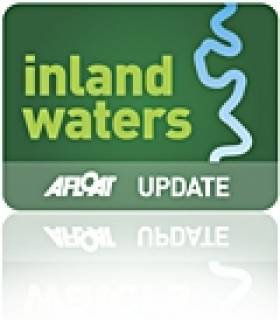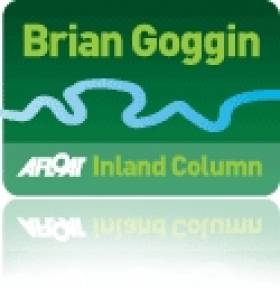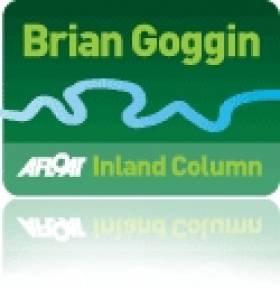Displaying items by tag: Royal Canal
Boating Traffic on the Grand & Royal Canals & River Barrow to be Impacted By Bye–Laws – IWAI
Carmel Meegan, President of the Inland Waterways Association of Ireland (IWAI) welcomed delegates to the IWAI National Council meeting in Tullamore on 8th confirmed that the proposed bye-laws do not put user requirements, local communities or tourism at the centre of the regulations. Delegates heard –
In general –
there are reports that boats present this time last year have now left the Canals – the IWAI says this is indicative of boaters' fears and a further future drop in navigation use
Waterways Ireland have suggested that the 1800 plus submissions delivered by IWAI - during the brief consultation period of only 21 days- are letters in support of the IWAI
Submission rather than viewing these as other individual submissions recognising the effort and concern held by wider communities
Waterways Ireland imposed restrictions never previously invoked on boats travelling by Canal to the Dublin Rally in 2014 – which is celebrating 40 years of community activity
the proposed toll €75 to travel between the Grand and Royal Canals is detrimental – the IWAI advises this is the now most expensive boat crossing in Europe
the Newcomen lifting bridge will open only 8 times this year, only 96 boats are permitted to undertake the Green & Silver route around the Grand and Royal Canals this season due to restrictions of use of the Newcomen lifting bridge, significantly curtailing the emerging 'Green & Silver' route – the IWAI advises this is a major miss for domestic and international boat tourism.
Concerns aired as to the Canals and Barrow as a tourism resource have included questions in the Seanad and the Dail; County Council input; national and local press articles; television and radio interviews; community websites; blogs and Facebook pages reflecting overall national concern.
Politically, this has grown to be a very big issue and is featuring highly as politicians face into local elections this summer. The IWAI have gained the interest of local, regional and national
politicians on this matter to date, and will present our position to the Oireachtas Joint Committee on the Environment, Culture and the Gaeltacht in Leinster House on 25th
The boating community is not averse to appropriate management, facility provision, and access to waterways. But boats are key attractions, as the lifeblood of the navigations, and need to be welcomed.
Fallen Tree Blocks Royal Canal's Richmond Harbour
MARINE NOTICE
No 4 of 2014
Shannon Navigation & Royal Canal
Clondara / Richmond Harbour
Waterways Ireland wishes to advise masters that a large tree has fallen across the navigation and is presently obstructing the entrance to Richmond Harbour and the Camlin jetties.
A further marine notice will issue when the navigation has been cleared.
#byelaws – Waterways Ireland invites people and organisations affected by the changes to the Draft Canals Act, 1986(Amendment) Bye-Laws, 2014 to make submissions to Waterways Ireland before the 3rd February 2014.
All the documents are available online and can be viewed by arrangement in Waterways Ireland offices in Enniskillen and Dublin. Submissions can be made online, by email, by post and by visiting Waterways Ireland offices.
Submissions are being sought on changes to the Bye-Laws on the Grand Canal, Royal Canal and Barrow Navigation. The Draft Canals Act, 1986(Amendment), Bye-Laws, 2014 includes a new management framework which will be used to manage continuous cruising, houseboats, dry dock facilities as well as key location & serviced mooring usage. The amendments also include changes to mooring times, charges and the introduction of a fixed penalty notice.
Waterways Ireland will consult with the groups representing the views of people affected by statutory equality regulations such as disability or age based groups. In addition Waterways Ireland will be holding meetings with groups where their members will be affected by the changes to the Bye-Laws. Letters have also been issued to all permit holders on the navigations affected by the Bye-Law changes informing them of the public consultation and the availability of the documentation.
The period for submissions is set by the Section 7(1) of the Canals Act, 1986 (No.3 of 1986) as amended by section 56 of the Maritime Safety Act, 2005 (No. 11 of 2005). The deadline for submissions is the 3rd February 2014. Documentation is available from www.waterwaysireland.org/Public-Consultation or from Waterways Ireland offices as listed.
Grand, Royal Canals & Barrow Navigation Planned Closures
MARINE NOTICE
No 130 of 2013
GRAND, ROYAL CANALS AND BARROW NAVIGATION PLANNED WINTER CLOSURES
2013-2014
Waterways Ireland wishes to advise Masters and owners of vessels that the following planned closures will be in place for the winter of 2013-2014.
Grand Canal – Main Line
Circular Line, Dublin The Circular Line of the Grand Canal is closed to navigation between Lock C3 (Upper Mount Street) and Lock C5 (Leeson Street) from October to December 2013 to facilitate the installation of new lock gates.
Ardclough, Co. Kildare The Grand Canal is closed to navigation on the 13 th Level, downstream of Ponsonby Bridge near Ardclough, Co. Kildare, from November 2013 to February 2014 to facilitate works by Kildare County Council associated with the construction of a new distribution watermain.
Sallins, Co. Kildare The public moorings immediately East and West of Sallins Bridge are closed until mid-March 2014 to facilitate the construction of new houseboat and public jetty facilities.
Ballycommon to Clonony,
Co. Offaly The Grand Canal is closed between the 34 th Lock at Clonony and the 21 st Lock at Ballycommon from Monday 4 th November until Friday 20 th December 2013 to facilitate maintenance works.
Grand Canal – Barrow Line
Vicarstown, Co. Laois Possible closure of the canal in the Vicarstown area to facilitate bridge repairs – further details to follow.
Royal Canal
Spencer Dock,
Newcomen Bridge There will be no further lifts of Newcomen railway bridge until the 2014 boating season.
Ashtown to Castleknock,
Dublin 15 The towpath of the Royal Canal between Ashtown (10 th Lock) and Castleknock (12 th Lock) is closed from October 2013 to February 2014, to facilitate the construction of new cycle path facilities. An alternative route for towpath users will be sign-posted.
41 st Level, Mosstown,
Co. Longford The Royal Canal is closed at Mosstown until further notice due to a collapsed culvert.
Barrow Navigation No closures are planned.
Charles Lawn
Lt Cdr(rtd)
Inspector of Navigation
21 November 2013
Tel: 353 90 6494232
Fax: 353 90 6494147
MARINE NOTICE
No. 97 of 2013
Royal Canal - Dublin
Towpath Closure
Level 1 – Binns Bridge to Russell St
Waterways Ireland wishes to advise that the above section of canal towpath on Level 1 of the Royal Canal Dublin has been closed to the public due to a wall slippage that occurred following heavy rainfall on Wednesday night.
Electrical and gas services run along the towpath so it has been closed as a precautionary measure until repairs are carried out. However, navigation will remain open as normal throughout this period.
Waterways Ireland apologises to its customers for any inconvenience caused.
C. Lawn
Inspector of Navigation
28 Jul 2013
Tel: 00353906494232
Fax:003539094147
#InlandWaterways - Waterways Ireland has advised all masters and users of the Erne system that the channel east of Castle Island near Enniskillen will be closed till Tuesday 11 June to facilitate a number of events on the water.
Mariners are directed to follow the marked navigation channel and signs to the west of Castle Island and proceed at a slow speed and with minimum wash. They should note any advise or instructions given by event organisers when in this section of the navigation.
Public jetties in the vicinity will remain accessible throughout, though some minor restrictions may be in place as and when required. Further information is available from the Lough Erne warden at 028 6632 3004.
Elsewhere, there will also be restricted mooring for masters and owners on the River Shannon at Carrick-on-Shannon to facilitate spectator viewing of the Carrick 400 event.
On Sunday 2 June the quay wall from the downstream face of the town bridge to the floating moorings will be out of bounds for mooring from 7pm till midnight.
In other waterways news, recent water quality testing has shown the harbour at Kilcock on the Royal Canal to now be within normal bathing water standards.
Water Patrollers For Royal Canal From Kilcock To Dublin
#InlandWaterways - Waterways Ireland advises that water control and boat assistance on the Royal Canal from Lock No 12 to 17 between Kilcock and Dublin (Castleknock) over the summer period will be provided by a full-time Water Patroller with assistance on weekends.
Des Phillips (contact 087 248 5754) will be on duty Monday to Friday from 8.30am till 5pm and on Sundays from 8.30am till 12.30pm.
PJ Massey (contact 087 985 7019) will provide water control and boat assistance on Saturdays from 8.30am till 12.30pm.
On Saturday and Sunday afternoons from 2pm till 6pm, cover will be provided by either Damien McDermott, JJ Brennan or David Whelehan (contact 087 177 8563).
Note that passage through Locks No 16 and 17 may not be possible outside of the hours listed above. Masters should therefore contact the relevant water patroller to arrange assistance through these locks.
Enforcement of Mooring Bye-laws on Grand & Royal Canal & Barrow Navigation
#byelaws – Waterways Ireland will begin enforcement of the mooring Bye-Laws on the Barrow Navigation, Grand Canal and Royal Canal on the 19th March 2013. A Marine Notice will be issued on the 19th March to this effect.
The enforcement process will begin with non-permitted, sunken and abandoned boats already on the system. The first step in the process is notification. Continued non-compliance with the Bye-laws may result in the craft being removed from the navigation and stored at the owners cost.
A one year permit for passage and 5 day mooring costs €126. A year-long mooring permit for a single location costs €152. For boats already on the canal system, both permits must be applied for in advance of the 19th March 2013 and be on display on the boat by the 31st March 2013.
New boats visiting the Grand Canal, Royal Canal or Barrow Navigation for longer than 1 month may apply for the CMP in advance of arrival on the system and must apply for the Extended Mooring Permit as soon as they plan to remain for longer than five days in a single location.
The application process is simple using a form that can be downloaded from www.waterwaysireland.org or sent out by post from Waterways Ireland Tullamore (Tel no 057 9352300).
Waterways Ireland has extended the number of Authorised Officers, who under the Bye-laws have the authority to undertake enforcement.
More information is available from Shane Anderson, Assistant Inspector of Navigation: Tel no +353 (0)87 286 5726, Email [email protected] .
Making Waves On The Canals
There's an old joke about a Scottish hellfire preacher trying to educate his flock about the punishment awaiting them if they do not mend their ways. He tells them that the ungodly will find themselves in the flames of hell, suffering unimaginable torments, and that they will cry to the lord for mercy, saying "Laird, laird, spare us: we didna ken whit torments awaited us." And, he tells them, the lord in his infinite goodness and mercy will gaze down upon them from heaven and he will say unto them "Well, ye ken noo".
WI and the canals
Some folk with boats on the Royal, Grand and Barrow may be feeling a bit like the ungodly at the moment, with the role of the lord being played by Waterways Ireland (WI). It seems that, as predicted here, WI is finally moving to take control of its canals.
Several new initiatives are under way, more are promised, some are predicted — and all in all it probably amounts to the biggest set of changes to boating on the canals since the end of commercial carrying. Furthermore, there are suggestions that the canals are being seen as a pilot study: that some of the changes will be applied to the Shannon and the Erne in years to come.
Cheap boating
Until now, you could keep a boat on the canals for e126 a year. That covered as many miles as you wanted and passage through as many locks as you wanted; it also covered mooring for the year. There is a bye-law that says you must not stay in one place for more than five days at a time, but it was widely ignored and scarcely ever enforced.
So you could, for example, keep your boat near Dublin, perhaps at a location close to a railway station, and live on it all year round. Or you could keep it there in the winter and move to the Shannon end for the summer, basing your boat at Shannon Harbour (Grand Canal), just one or two locks away from the Shannon, or at Richmond Harbour (Royal Canal), just one lock away. The cost was well below that of a Shannon marina berth.
The bye-laws simply did not reflect the ways in which people actually used boats, either as pleasure craft or for living on. And the charges to users were well below the cost of competitors' products (e.g. commercial marinas' charges), well below the charges on UK waterways and, in particular, well below the cost of running the waterways.
Costs to taxpayers
In the year ended 31 December 2010, WI's operating income, excluding "net deferred funding for pensions", was e547,000. That's the total for all waterways, coming from licences (e34,000), property (e210,000), operations (e202,000), interest (e1,000) and other (e100,000). The programme costs (excluding staff and other costs) were:
• Barrow e723,000
• Grand e2,074,000
• Royal e2,873,000
• the rest e2,098,000.
So the Grand, by itself, cost almost as much as the Lower Bann, the Erne, the Shannon and the Shannon–Erne Waterway put together. The Barrow, Grand and Royal accounted for 73% of the costs but for a far lower proportion of the boats and the income.
I don't intend that as a reflection on the efficiency with which the different waterways are operated: canals are entirely different in nature to river and lake navigations, with far more waterways infrastructure, and will cost more to run. But I give the figures for two reasons. First, they show that, if WI wanted to reduce the gap between income and expenditure, it would inevitably focus on the canals. Second, the figures give some idea of the extent of the subsidy being provided by the taxpayer to canal-based boaters: if there are, say, a thousand boats based on the canals and Barrow, each of them is being subsidised by (on average) about e5,500 a year from the taxpayer.
Costs to boaters
I'm always inclined to look at the economic angle, but WI doesn't dwell on it. Nonetheless it will increase the costs to boaters and will also increase WI's income. Instead of a single e126 annual charge, boaters will now pay
• e126 for a Combined Mooring
& Passage Permit
• e152 for an Extended Mooring
Permit (EMP)
• e250 as a damage deposit,
which I presume will be rolled
forward in succeeding years.
Furthermore, boaters applying for Extended Mooring Permits (EMPs) must produce insurance certificates; for anyone currently uninsured, that will be an extra cost, as will any survey and remedial work required.
There will be other extra costs, of which more below, in future years.
Controlling mooring
At the core of WI's current activity is its taking control of the banks. It is marking out lengths that can be allocated to boats; it will allocate those lengths to those applying for EMPs. It does not guarantee that boaters will get their preferred spaces, or that they will get the same space every year. But once a space has been allocated, it is reserved for one boat for the year and cannot be used by another. That probably seems obvious to anyone renting a marina berth but it will be a new practice on the canals.
The EMP system was applied first at Rathangan and Vicarstown on the Barrow Line, between Lock 34 and Griffith Bridge on the Grand and at Confey (Leixlip), 15th Lock and 45th Lock (near Richmond Harbour) on the Royal. The second batch will include places in the Grand Canal Dock in Dublin, at Pike Bridge, near Maynooth, and at Abbeyshrule on the Royal and near Lock 34 on the Royal. There will be more batches through to spring 2013; full details on http://www.waterwaysireland.org; select New Canal Permit System from the menu on the left.
Continuous Cruisers (as they're called in Britain), folk who stay no more than five days in one location, will not be required to have EMPs.
So what happens if a boater doesn't apply for an EMP but doesn't cruise continuously? If I'm reading the bye-laws correctly, WI has the power to remove a boat, store it and, if necessary, sell it, charging the owner for the costs of doing so.
Information or consultation?
There has been some criticism of WI for not holding consultation meetings before beginning to implement its new policy. My own view is that WI was right: such meetings produce more heat than light, with too much attention on minor individual matters and not enough useful comment on the principles. There is much to be said for creating facts on the ground.
But if consultation has been restricted, the flow of information has not. In fact WI has used its website very effectively, setting out its plans, explaining the procedures and providing FAQs with useful, not PR-type, answers. Whoever has been in charge of that exercise deserves to be commended.
Insurance and dry docking
One thing WI has communicated is that there is more to come.
From 2015 Waterways Ireland will be introducing the requirement for boats needing permits and wishing to use the canals to have a current hull survey to provide evidence that the boat is in good condition. [...] Your attention is being drawn to this requirement now to allow you time to prepare for 2015. [...]
The Licensee undertakes to have regular inspections of the gas and electric services of his Boat as required to ensure these are kept in a safe and serviceable condition. [...]
All Boats must carry adequate fire fighting equipment and have same serviced as per the manufacturer's recommendations. [...]
It is not permitted to re-fuel Boats at an extended mooring.
The requirement for insurance will probably mean more boats needing hull surveys; there is an explicit requirement for such surveys from 2015 onwards. That will put extra pressure on the dry docks, where WI has already introduced restrictions on the boats that can use them and the work that can be carried out. There is, in my view, an urgent and growing need for well-capitalised, well-managed boatyards along all our waterways. The requirements also suggest a need for more fuel sellers along the canals; as far as I know the only one is at Lowtown.
The Shannon and the Erne
The new arrangements will mean better management of the canals, safer boats and more income from WI, all desiderata. But the real excitement would come with their extension to the Shannon and the Erne. The legal basis for charging might have to be different, but WI must surely be planning to raise much more money from Shannon and Erne boaters. The current Shannon lock and bridge fees are pathetically small, hardly worth collecting, and they are not paid at all by those who stay on the lakes.
I am writing this before the Republic's budget is published, but I cannot imagine that it will contain good news for WI. I suspect that it will have to raise much more money itself, and that means from charges to various types of users. Robin Evans, chief executive of Canal & River Trust, which runs the former British Waterways navigations in England and Wales, said recently that his organisation gets only 35% of its funding from the State. The Irish Government must look enviously at that figure.
But it must consider the price elasticity of demand for inland boating. Usage, as measured (however imperfectly) by Shannon lock and bridge passages, has been falling over the last ten years. The chart below shows the figures for the first ten months of each year: at time of writing, figures for November and December 2012 were not available.
It may be time to reinvent the Shannon once again.
Down On Derg
For the last couple of years, we've done some long-distance boating; indeed in 2011 we didn't get to Lough Derg until the end of September. So we decided that, this year, we were not going anywhere north of Portumna: we would spend the year down on Derg.
Here are some of my impressions of the season. Some of them I may be able to check later, by looking for statistics or reports; some can't be checked because there are no statistics.
Weather
My first impression is that summer ended some time around May, with relatively little sunshine after that.
Even the nature of bad weather seems to have changed: the Royal Canal ran out of water in Spring but the Shannon had rather a lot of water throughout the summer. From time to time reports came from upstream of strong flows that made navigation difficult; down on Derg, Killaloe seemed to have strong currents quite a lot of the time, with water being pulled down the headrace to Ardnacrusha.
Met Éireann's report for the summer (June, July, August) seems to support that view: rainfall above average, sunshine and temperatures below average. It also seemed to me that we had more northerly winds than usual: the south-westerlies didn't seem to be the prevailing winds. However, the report says nothing about winds.
Numbers
My second impression is that lots of people have disappeared: that very few boats were moving on the lake this year: it was as if we were back to the early 1980s. I'll get the traffic figures from Waterways Ireland later: they cover only passages through locks and moving bridges, so they don't say anything directly about lake traffic, but they do give an idea of volumes.
Now, I may not be the best judge of numbers of boat movements because, if I hear there's a big boaty event on, I go somewhere else. But there seemed to be times when there was nothing moving on the middle of the lake, except sailing boats racing from Dromineer, Garrykennedy or Mountshannon. There weren't even many jetskis or speedboats around.
There were rumours of larger boats being sold to overseas buyers and transported out of the country, but I don't know how to check that. Even checking the total number of Shannon boat registrations wouldn't help: as there is no annual registration fee, there is no incentive for former owners to de-register boats that have been sold.
Dromineer
My third impression is that shore-based activity has diminished too.
As we keep our boat in the Shannon Sailing marina in Dromineer, we don't often use the public harbour, but we drive by it en route to the marina. It seemed to me to be pretty lifeless. Numbers of visiting boats seemed to be down (while numbers of resident boats rose), as did numbers visiting by land. (I don't know of any source of statistics for this; if there is one I'd like to know.)
I imagine that the poor weather kept land visitors away, except on the few sunny days. But I don't think that the improvements made a few years ago — path, pebbles, seats and so on — have done much to attract people. Dromineer needs to do more to establish itself as a place to visit, with things for people to do when they get there.
Harbour hoggers
My fourth impression is that harbour-hogging — leaving boats in public harbours for more than the permitted numbers of days, instead of paying for berths in private marinas — is on the increase. I don't know of any statistics on this, although I suspect that Waterways Ireland may have some. Its staff do patrol the harbours and record registration numbers, occasionally applying stickers to errant boats, so I imagine that they keep records of the numbers.
The problem is that WI has very little power, under the current bye-laws, to do anything effective. It needs a simple, cheap method of imposing ever-increasing charges on harbour-hoggers — and of enforcing payment. Experience with both the household charge and the mineral oil tax suggests that drastic steps may be required.
Other privatisers
The same may apply to other services that WI provides. Its very welcome supply of electricity can at least be controlled, with charges paid by card. However, I suspect that, when water charges are introduced, WI will have to devise a method of charging for water. Whether or not it wants to subsidise boaters, it is unlikely to want to supply folk who drive to its harbours to fill barrels and bottles with water (I have photographed folk doing just that).
And then there's the rubbish problem. Bins have been removed from some harbours on the west side of Lough Derg; a WI notice says that it has a "Leave No Trace" policy, or some such thing. That doesn't explain why there are still bins at harbours on the east side; I suspect that the explanation is in different arrangements with different local authorities. However, overseas tourists (if there are any) are likely to find it a little inconvenient to bring their holiday rubbish home with them, especially if they're flying by Ryanair.
But you can see WI's problem: if it makes free bins available, folk will drive from miles around to avoid paying charges. So, given that Irish folk are unlikely to develop civic-mindedness in the near future, the best solution is to use smart-card controlled bins, with each opening of the lid traceable to the individual boat-owner (or camper-van-owner). The same cards could control the other services and provide WI with a way of tracing user movements.
Supply and demand
The problem with free services is that they're too good to last: the provider, especially if it gets its money from an overstretched state, eventually realises it can't continue to provide them for nothing. So, just as declining income and other pressures reduce demand for its product, Waterways Ireland may find itself imposing extra charges that further reduce demand. It is not clear that any marketing campaign can compensate for the economic pressures on the sector.



























